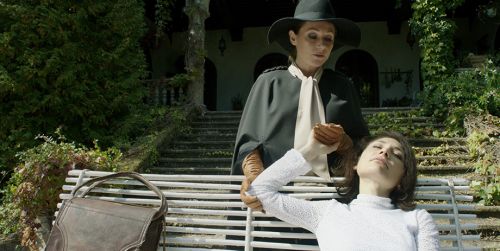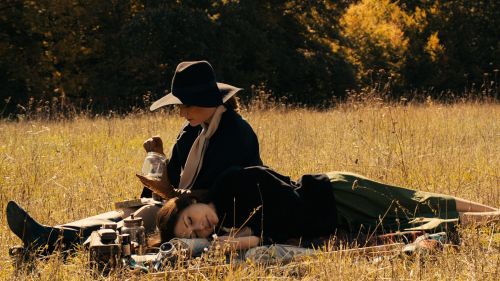The Duke of Burgundy operates within its own discrete, sumptuous universe: an unspecific European state seemingly without men, populated by women whose interests are limited to sadomasochism and the study of butterflies.
A complex erotic drama influenced by 1970s sexploitation cinema, Peter Strickland's third feature is ostensibly about the sexual relationship between Cynthia (Sidse Babett Knudsen) and Evelyn (Chiara D'Anna), but through deliberate repetition reveals itself to be a tender and funny look at the everyday struggles of making a relationship work. Peter sat down with us ahead of the film's release to talk about dodgy bookshops and imaginary perfumes.
Outside of the S&M window dressing, the central relationship in The Duke of Burgundy is fairly universal. What was the value of using one thing to bring out the other?
It's something I really enjoy: through something that is unrecognisable for many people in the audience, you perhaps see something familiar. I'm assuming the film's a spectacle and slightly sensational for a lot of people, but by normalising it you get into the meat of the story, which is the characters' motivation within their dynamic. For me, the film is about consent and how that veers into compromise and eventually coercion. Everyone likes to think they don't coerce their partner. Compromise is an issue within every element of a relationship, not just the sexual parts – if a couple decides to start a family, one person will possibly have to compromise on a job they might love. I'm not an agony aunt, but you can apply the film beyond the bedroom.

What appealed to you about taking a genre like sexploitation that's generally viewed in low-standing and repurposing it?
I'm a bit of dumpster diver. I like going through things that people overlook and disregard, and I'm very aware that this genre is one of the few in cinema that's never really been propped up or defended. Grindhouse had a light shone on it, and Italian giallo horror for sure, but not sexploitation. Anything to do with sex is just seen as a bit embarrassing. Even to to get a hold of these films you used to have to go into dirty bookshops on Charring Cross Road. There are some very bad ones of course, with no redeeming qualities, but there are also ones which are brilliant all the way through. I remember a film I saw at the Scala Cinema 24 years ago called Mano Destra, by Cleo Übelmann. It's this bizarre black and white film, like Chris Marker doing a bondage film, almost a still life. So I'm not trying to look down on them. I think in general these films embodied a fantasy, like the stern prison warden and the poor prisoner being sexually humiliated and so on. What propelled me was the sleazier elements, not that female lovers are sleazy, but the intention was sleazy because it was made for a male heterosexual audience. The idea was to take some of the fantastical imagery and puncture it, or turn it inside out.
Your previous film Berberian Sound Studio was a film ostensibly about horror and violence that didn't have either of those things, and this is a film ostensibly about a sexual relationship that doesn't show the actual sexual component of it. Why did you choose to imply rather than depict?
I toyed with showing sex. The script was quite explicit, but I didn't want to compete with other things. I knew Nymphomaniac was getting made at the time, and there was Blue is the Warmest Colour. Even if you don't want to, it can end up as this kind of sexual one-upmanship. I thought the best approach was to just hold back. I was also very aware of being a man, and thought it was important to not be too directional with the way the camera was looking. I was really conscious of the pitfalls of that. If I'd made the film with two men I probably would have done it differently, and it would have been quite graphic. Ultimately I chose two women because that's the genre staple.

The setting and era of the film is purposefully vague. What was your thinking behind that? It could be the 1970s, it could be now...
It could be the future! Sometimes it's hard to say why you do things. I liked the idea of this middle Europe. Practically it makes sense when you have actors with different accents, so the mix doesn't feel too disruptive. The first draft had men, the characters had jobs, they lived in the city. I thought let's actually make this kind of preposterous: a world where they have a house no-one can afford, and there are no men, and everyone is doing the same activity. It's not realistic at all. By that, perhaps, you focus on the dynamics of the relationship. For me the fact that there are no men makes it not a classic lesbian story because there is no other gender to have a counterpoint. There's no other sexuality to have a counterpoint, because there aren't even heterosexual women. I didn't want to make it about that, because then you get into the idea of social acceptance, rather than the things I was interested in.
Listed among the opening credits is “Perfume by Je Suis Gizella”. Did you actually use perfume on set?
That perfume didn't exist. It does now. We didn't know we'd have such a strong reaction so we've actually produced a limited edition perfume. I stole the idea from an Audrey Hepburn film, Paris When It Sizzles, which lists her perfume as being by Givenchy. Nobody's seen that film so I thought I could get away with it. My job is to get the audience in the world of the film as quickly as possible. Credits are not just functional, informational space – you can play with them to create mood, and perfume makes you think this is a heady, sensual, decadent world.
The Duke of Burgundy is out now.


